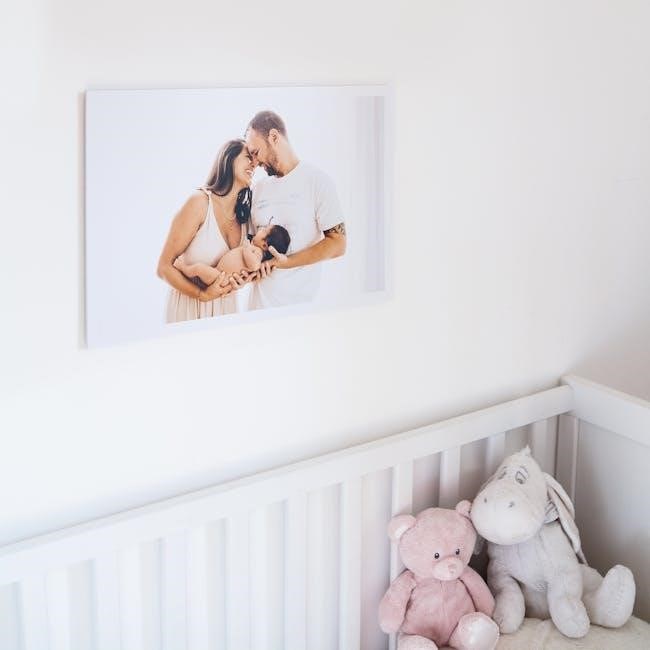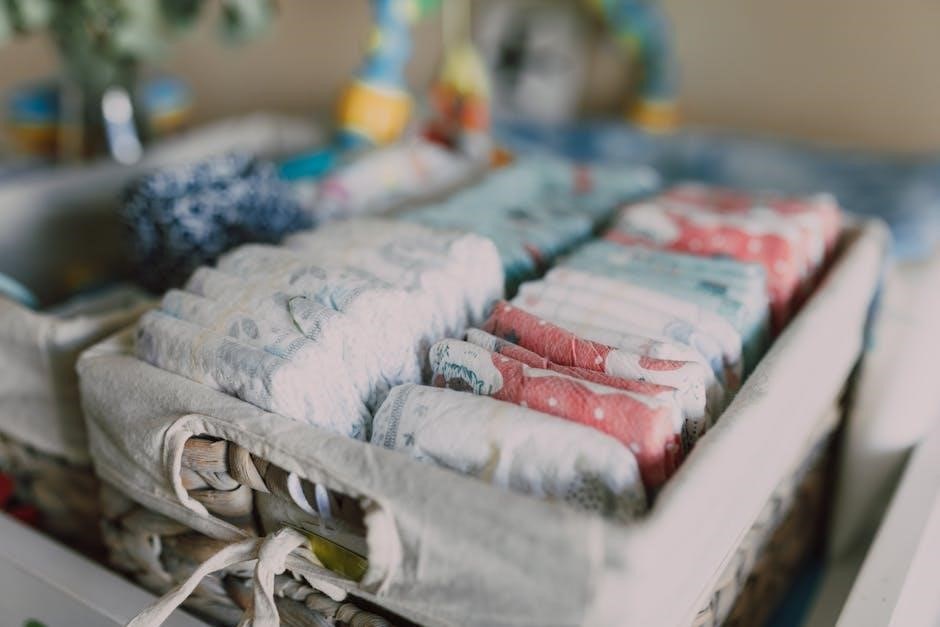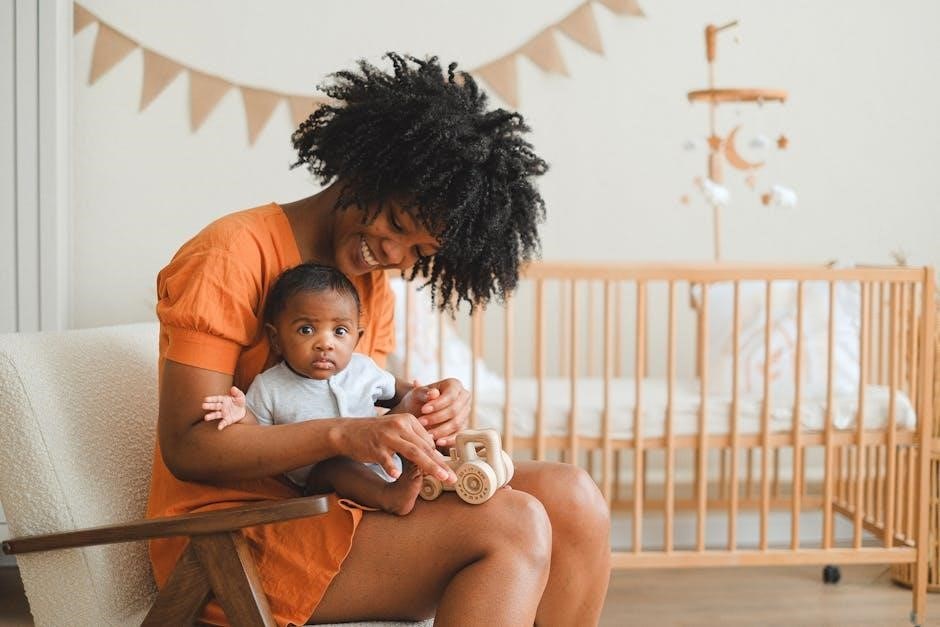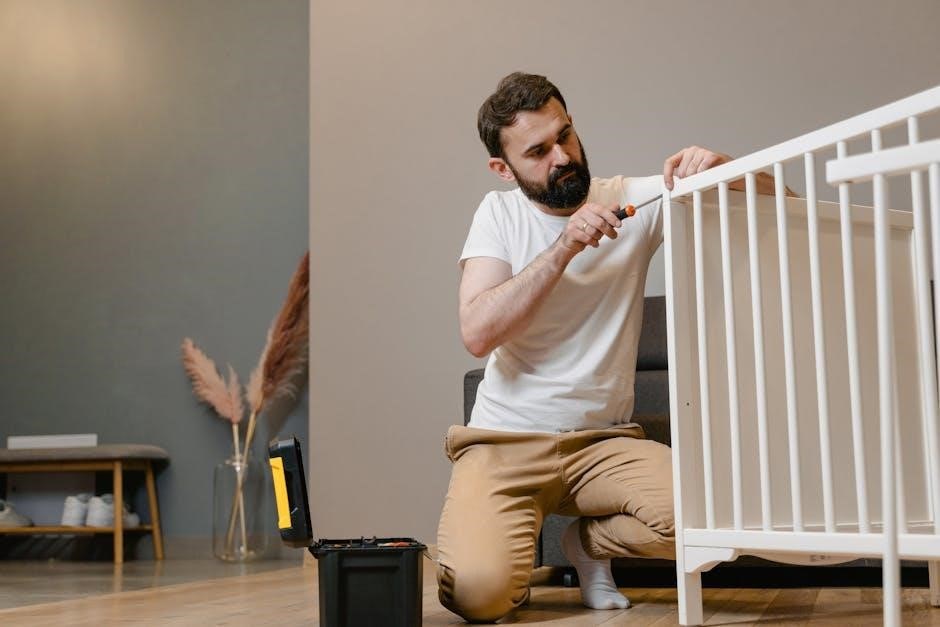
jenny lind crib instructions
The Jenny Lind crib is a popular choice for its classic design, durability, and versatility. Known for its timeless aesthetic, it offers a safe and stylish solution for nurseries. The crib’s instructions are detailed, ensuring proper assembly and safety for your child;

1.1 Overview of the Jenny Lind Crib Design
The Jenny Lind crib is celebrated for its timeless and classic design, featuring elegant spindle legs and a simple, yet sophisticated appearance. Its 3-in-1 convertible feature allows it to transition from a crib to a toddler bed and beyond, offering long-term versatility. Crafted with durable materials, the crib ensures safety and stability, meeting rigorous safety standards. The design is available in various finishes, making it easy to complement any nursery decor. Its compact footprint and adjustable mattress height cater to growing needs, while the overall aesthetic remains timeless and charming, appealing to parents seeking both functionality and style.
1.2 Importance of Proper Assembly and Instructions
Proper assembly of the Jenny Lind crib is crucial for ensuring the safety and structural integrity of the crib. Incorrect assembly can lead to potential hazards, such as loose parts or instability, which may compromise your child’s safety. Following the provided instructions carefully guarantees that all components are securely fitted and functional. This step is vital for preventing accidents and ensuring the crib meets safety standards. Additionally, proper assembly preserves the crib’s durability and aesthetic appeal, making it a long-lasting investment for your child’s nursery. Always double-check each step and verify that all hardware is tightened properly before placing your child in the crib. By adhering to the instructions, you can create a secure and comfortable environment for your baby to sleep and grow.

Preparing for Assembly
Begin by gathering all tools and materials, ensuring you have an Allen wrench and screwdriver. Organize crib components and read instructions carefully to ensure a smooth process.
2.1 Tools and Materials Needed
Before starting the assembly of your Jenny Lind crib, gather all necessary tools and materials. Typically, you’ll need an Allen wrench (provided in the kit) and a screwdriver for securing bolts and screws. Ensure all parts are included in the packaging, such as the crib frame, sides, back panel, mattress support, and hardware. Double-check the instruction manual for specific tools recommended by the manufacturer. Additional items like a rubber mallet (for tapping parts into place) or a measuring tape might be helpful. Organize all components and tools in a clear workspace to streamline the process. Having everything ready ensures a smooth and efficient assembly experience.

2.2 Understanding the Crib Components
Understanding the components of the Jenny Lind crib is essential for successful assembly. The crib typically includes a sturdy frame, side panels, a back panel, mattress support, and hardware. The frame serves as the base, while the side and back panels provide structure and safety. The mattress support ensures proper positioning and stability for the mattress. Hardware such as bolts, screws, and brackets is critical for securing all parts together. Additional components may include conversion kits for toddler bed transitions. Each part is designed for durability and safety, often made from solid wood or high-quality materials. Familiarizing yourself with these components will help you identify them during assembly and ensure everything fits correctly. Properly understanding each part is the first step toward building a secure and comfortable crib for your child.
2.3 Safety Precautions Before Starting
Before assembling the Jenny Lind crib, ensure a safe working environment. Clear the area of clutter and cover the floor to protect it from damage. Wear gloves to handle sharp edges and heavy components. Use the correct tools to avoid stripping screws. Follow the manual step-by-step to prevent mistakes. Ensure all parts are securely tightened to maintain stability. Avoid over-tightening, which could damage the wood or hardware. Keep children and pets away during assembly. Double-check each step for accuracy. If unsure, consult the manufacturer’s support or a professional. Proper assembly ensures the crib’s safety and durability for your child.

Step-by-Step Assembly Guide

Begin by unpacking and organizing all parts. Follow the manual to build the frame, attach sides, and secure hardware. Ensure each step is completed carefully for stability and safety.
3.1 Unpacking and Organizing Parts
Begin by carefully unpacking the Jenny Lind crib components from their boxes. Lay out all parts on a clean, flat surface to ensure nothing is missing or damaged. Use the inventory list provided in the instruction manual to verify each item, such as the crib frame, sides, back panel, mattress support, and hardware. Organize the parts by category or label them according to the assembly guide for easier access. Separate screws, bolts, and other hardware into small containers to avoid misplacement. This step ensures a smooth assembly process and prevents delays. Double-check that all pieces are accounted for before proceeding to the next step.
3.2 Building the Crib Frame
Building the crib frame is the foundation of the assembly process. Start by attaching the legs to the frame using the provided bolts and Allen wrench. Ensure all parts are securely tightened to avoid wobbling. Next, connect the side panels to the frame by aligning the pre-drilled holes and inserting the screws. Use a level to confirm the frame is even and stable. Double-check that all bolts are tightened firmly to ensure structural integrity. Once the frame is fully assembled, place it on a level surface to prepare for attaching the mattress support and other components. Proper alignment and tightness are crucial for safety and durability.
3.3 Attaching the Sides and Back Panels
Once the frame is built, align the side panels with the crib’s base, ensuring they fit snugly into the pre-drilled holes. Use the Allen wrench to secure them with the provided bolts, tightening firmly but avoiding overtightening. Repeat this process for the back panel, centering it carefully for a balanced look. Double-check that all panels are flush with the frame and that no gaps are visible. Once secured, gently rock the crib to ensure stability. If any movement is detected, tighten the bolts slightly. Note that these panels should not be over-tightened, as this could damage the wood or hardware. Proper alignment and secure attachment are critical for safety and durability, especially for future conversions to a toddler bed.
3.4 Installing the Mattress Support
Installing the mattress support is a critical step in ensuring your crib is safe and functional; Locate the mattress support board, typically a slatted or solid panel, and align it with the crib frame. Attach the support using the provided screws or clips, following the manufacturer’s instructions. Ensure the support is level and securely fastened to prevent any movement. Double-check that all bolts or hardware are tightened properly. The mattress support should fit snugly within the crib frame, leaving no gaps. Once installed, place the mattress inside to confirm it lies flat and even. Avoid over-tightening, as this could damage the crib. Always refer to the specific instructions for your model, as variations may exist. Proper installation ensures the crib meets safety standards and provides a comfortable sleeping surface for your child.
3.5 Securing the Crib Hardware
Securing the crib hardware is a critical step to ensure stability and safety. Begin by tightening all bolts and screws firmly using the Allen wrench provided. Double-check that all connections, such as the side rails and mattress support, are tightly fastened. Pay particular attention to the crib’s joints, as they bear the most weight. Use the instructions to identify and tighten any hidden bolts or brackets. Once all hardware is secured, gently rock the crib to ensure there is no wobbling or movement. If any looseness is detected, tighten the relevant bolts immediately. Finally, perform a final inspection to confirm that all parts are properly aligned and secure. A sturdy crib ensures your child’s safety and provides peace of mind for parents.

Converting the Crib
Converting the Jenny Lind crib involves transitioning it into a toddler bed or other configurations. This process typically includes installing toddler rails and adjusting mattress height for safety and comfort.
4.1 Converting to a Toddler Bed
Converting the Jenny Lind crib to a toddler bed is a straightforward process that extends its usability. Begin by removing the crib side panel to create an open bed design. Ensure you have the toddler rail, typically included or available as a conversion kit. Attach the rail securely to the crib frame using the provided hardware. Tighten all bolts firmly to ensure stability. Position the mattress at the lowest setting to accommodate your child’s growth. Double-check that all connections are secure to prevent any wobbling. Follow the manufacturer’s instructions precisely to guarantee safety. This transition marks an exciting milestone, offering your child a comfortable and safe sleeping environment as they grow. Always ensure the crib meets current safety standards and consult the manual for specific guidance.
4.2 Adjusting the Mattress Height
To adjust the mattress height on the Jenny Lind crib, locate the adjustment mechanism, typically found at the bottom of the crib. Using an Allen wrench or screwdriver, lower or raise the mattress support brackets to the desired position. Ensure the mattress fits snugly and the crib remains stable. Adjust the height as the baby grows, following the manufacturer’s guidelines for safety and weight limits. Always refer to the manual for specific instructions and recommendations to ensure a secure and safe sleeping environment for your child.
4.3 Adding or Removing Conversion Kits
Adding or removing conversion kits for the Jenny Lind crib is a straightforward process when done correctly. Always follow the manufacturer’s instructions to ensure safety and proper fit. Start by gathering the necessary tools and parts, such as Allen wrenches or screws, as specified in the manual. Detach any bedding or accessories before making adjustments. To add a conversion kit, align the pieces with the crib frame and secure them tightly. For removal, reverse the installation steps, ensuring all hardware is safely stored. If converting to a toddler bed, optional conversion rails may be required. Regularly inspect the crib after adding or removing kits to ensure stability and safety. Properly securing the kits will extend the crib’s lifespan and adapt it to your child’s growing needs.

Safety and Maintenance Tips
Ensure crib stability, inspect parts regularly, and clean with a damp cloth. Maintain a firm mattress fit and check hardware tightness for lasting safety and durability.
5.1 Ensuring Crib Stability and Safety
Ensuring the stability and safety of the Jenny Lind crib is crucial for your child’s well-being. Begin by following the assembly instructions precisely to avoid any structural weaknesses. Regularly inspect the crib for loose or wobbly parts, tightening hardware as needed. The mattress support should be firmly secured and adjusted to the appropriate height for your child’s age. Always use a firm, snug-fitting mattress and avoid adding extra padding or soft bedding, which can pose a suffocation risk. Additionally, keep the crib away from windows, curtains, and any dangling cords to prevent accidental entanglement or falls. Finally, check the crib’s weight limit and ensure it is not exceeded. By adhering to these guidelines, you can create a safe and secure sleeping environment for your child.
5.2 Regular Inspection of Crib Parts
Regular inspection of the Jenny Lind crib parts is crucial for maintaining safety and functionality. Check all bolts, screws, and slats for tightness and integrity. Ensure the mattress support is securely attached and even. Inspect wood surfaces for cracks or damage and hardware for wear and tear. Clean dust and debris from crevices to prevent potential hazards. Refer to the manual for specific inspection guidelines tailored to your crib model. Schedule inspections monthly and after moving or adjusting the crib. Address any issues promptly to ensure a stable and secure environment for your child.
- Examine all joints and connections for stability.
- Verify that all safety features are intact.
- Ensure no parts are missing or damaged.
This routine helps prevent accidents and extends the crib’s lifespan.
5.3 Cleaning and Maintaining the Crib
Regular cleaning and maintenance are essential to keep the Jenny Lind crib in excellent condition. Use a soft, damp cloth to wipe down surfaces, avoiding harsh chemicals or abrasive cleaners that could damage the finish. For stubborn stains, a mild soap solution can be applied, but ensure the crib is thoroughly rinsed and dried afterward. Avoid exposure to direct sunlight or moisture, as this may cause warping or discoloration. Inspect the crib regularly for loose hardware or wear and tear, tightening any screws or bolts as needed. Mattress support slats should also be checked for stability; Dust and vacuum the crib area frequently to prevent dust buildup. Always refer to the manufacturer’s guidelines for specific care instructions to ensure longevity and safety.

Troubleshooting Common Issues
Address loose parts by tightening hardware. Check for gaps or misalignment and adjust components. For wobbling, ensure all legs are level and stable. Refer to the manual for specific fixes.
6.1 Fixing Loose or Wobbly Parts

To address loose or wobbly parts on your Jenny Lind crib, begin by inspecting all bolts and screws. Ensure they are tightly secured without over-tightening, which could damage the wood or strip screws. Check the alignment of all components, as misalignment can cause instability. Verify that the mattress support is properly installed and that the mattress fits snugly. If the crib is on an uneven floor, consider using a level or padding under the legs. Review the assembly manual to ensure no steps were missed. If parts appear worn, replace them with manufacturer-approved hardware. Finally, ensure the crib is within its weight limit and consider professional assistance if issues persist.
6.2 Addressing Gaps or Misalignment
If you notice gaps or misalignment during or after assembly, inspect the crib for improper fitting of parts. Ensure all bolts and screws are tightened securely, as loose hardware can cause misalignment. Check for any parts that may have been installed incorrectly, such as panels or slats. Use an Allen wrench to adjust bolts gently, ensuring proper alignment without over-tightening. If gaps persist, refer to the manual for specific instructions on adjusting certain components. For example, side panels may need slight repositioning, and mattress supports should align perfectly with the frame. Regularly inspect the crib for any shifting parts and address them promptly to maintain stability. If issues remain, consider disassembling and reassembling the affected sections. Always prioritize your child’s safety by ensuring the crib remains sturdy and even.
7.1 Final Check and Enjoying Your Crib
With careful assembly and maintenance, the Jenny Lind crib provides a safe, stylish space for your child. Enjoy the satisfaction of a job well done and a happy nursery.
After completing the assembly and conversion processes, perform a final inspection to ensure all parts are securely attached and aligned. Double-check the hardware, mattress support, and panel fittings for stability. Once everything is in place, your Jenny Lind crib is ready for your baby. Appreciate its classic design and durability, knowing it provides a safe and comfortable space for your child. Regularly inspect the crib for any signs of wear and tear to maintain its integrity. With proper care, the Jenny Lind crib will serve your family well through the years, adapting to your child’s growth with its convertible features.